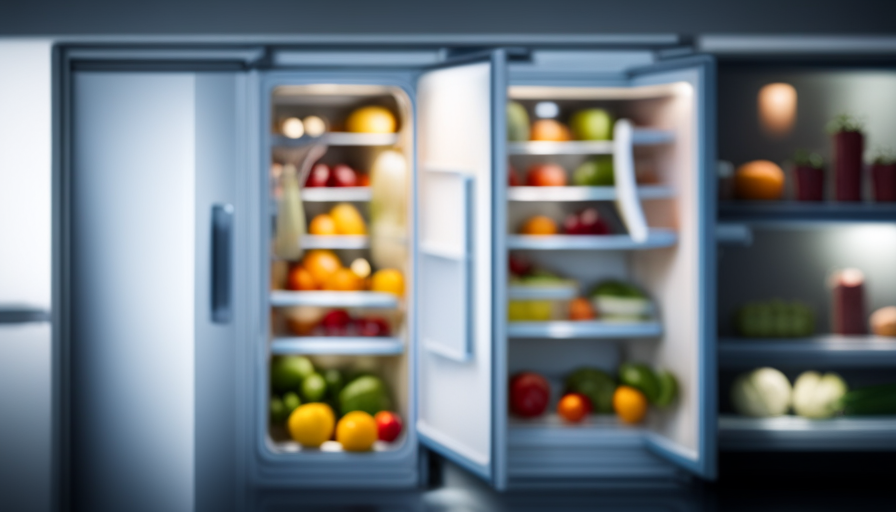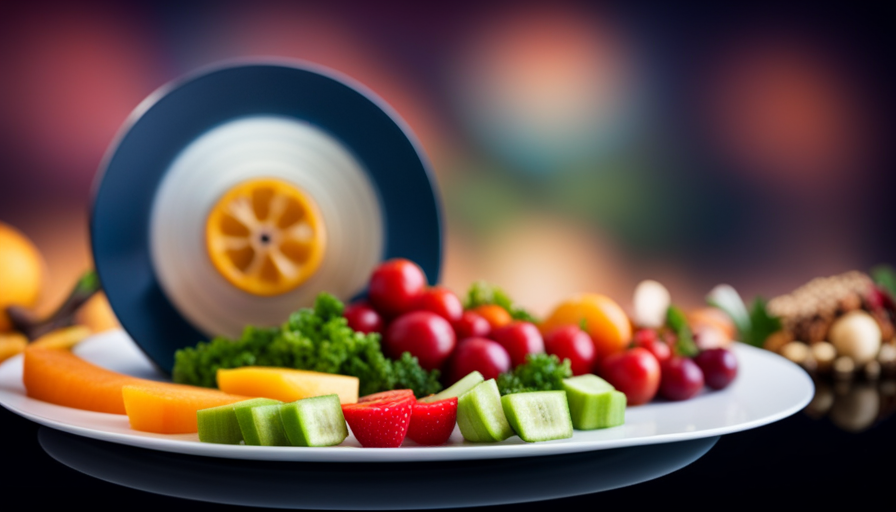Imagine your refrigerator as a treasure trove, brimming with fresh and colorful ingredients just waiting to be converted into mouthwatering dishes. Similar to a time capsule, the refrigerator helps maintain the freshness and quality of the food, but for how long? How much time do you have before that perfectly ripe avocado or succulent steak start to lose their appeal?
In this article, I will explore the fascinating world of raw food storage in the refrigerator and provide you with evidence-based tips to maximize their shelf life. From understanding food labels and expiration dates to proper storage techniques and temperature control, we will delve into the secrets of keeping your raw ingredients at their peak.
We will also discuss signs of spoiled food, best practices for extending shelf life, and even creative ways to use leftover raw ingredients. So, open the doors of your refrigerator and let’s embark on this journey together, unlocking the secrets to keeping your raw food fresh and delicious.
Key Takeaways
- The expiration date on raw food indicates the date by which it should be consumed for optimal quality.
- Proper storage techniques and temperature control, such as setting the refrigerator at or below 40°F (4°C), can extend the shelf life of raw food.
- Storing raw meat, poultry, and seafood in sealed containers on the bottom shelf of the refrigerator helps prevent cross-contamination and spills.
- Freezing raw food in airtight containers, using techniques like flash freezing, can effectively extend its shelf life by inhibiting the growth of microorganisms. Thawing should be done in the refrigerator or using the cold water method while changing the water every 30 minutes.
Understanding Food Labels and Expiration Dates
Do you ever find yourself confused about those mysterious numbers and letters on food labels, wondering how long your raw food will actually last in the refrigerator? Understanding food labels and expiration dates is essential for food safety and preventing foodborne illnesses.
The information on food labels provides valuable insights into the freshness and shelf life of the product. The expiration date indicates the date by which the food should be consumed for optimal quality. However, it’s important to note that raw food can still be safe to eat even after the expiration date has passed, as long as it has been properly stored.
To ensure food safety, it’s crucial to understand the different types of expiration dates commonly found on food labels. ‘Sell by’ dates are intended for retailers and indicate the last date the product should be sold. ‘Use by’ or ‘best by’ dates, on the other hand, are meant for consumers and suggest the last date for consuming the food while it’s at its peak quality. These dates are not strict deadlines for consumption but rather guidelines for optimal freshness.
Proper storage techniques for raw food play a vital role in maintaining its quality and safety. By storing raw food at the correct temperature, such as below 40°F (4°C), you can extend its shelf life. Additionally, keeping raw meats and other perishable items in sealed containers or wrapping them tightly in plastic wrap can help prevent cross-contamination and maintain freshness.
Understanding food labels and practicing proper storage techniques are key to maximizing the lifespan of your raw food while ensuring its safety.
Proper Storage Techniques for Raw Food
To ensure optimal freshness, it’s essential to store raw food properly in the refrigerator. This not only ensures food safety but also helps prevent food waste. Proper storage techniques for raw food involve maintaining the right temperature and keeping the food in appropriate containers.
One way to achieve this is by using airtight containers or resealable bags to store raw meats, poultry, and seafood. This helps prevent cross-contamination and keeps the food fresh for longer. Additionally, it’s important to store raw food on the bottom shelf of the refrigerator to prevent any drips or spills from contaminating other foods.
Here’s a table that provides a quick reference guide on the recommended storage times for different types of raw food in the refrigerator:
| Raw Food | Storage Time (Refrigerator) |
|---|---|
| Raw meat | 2-4 days |
| Raw poultry | 1-2 days |
| Raw seafood | 1-2 days |
| Raw eggs | 3-5 weeks |
| Raw vegetables | 1-2 weeks |
By following these proper storage techniques and adhering to the recommended storage times, you can ensure the freshness and safety of your raw food. In the next section, we will explore the importance of temperature control in maintaining the quality of raw food.
The Importance of Temperature Control
Ensure that you maintain the proper temperature in your refrigerator to preserve the quality and freshness of your raw ingredients. Temperature control plays a crucial role in ensuring food safety, as it can prevent the growth of harmful bacteria and extend the shelf life of your raw food.
Here are four key points to consider:
-
Set the temperature: Keep your refrigerator at or below 40°F (4°C) to slow down bacterial growth. Use a refrigerator thermometer to ensure it stays within this safe range.
-
Store raw food properly: Place raw meat, poultry, and seafood in sealed containers or wrapped securely to prevent cross-contamination. Keep them on the lower shelves, so any potential leaks do not contaminate other foods.
-
Avoid temperature fluctuations: Opening the refrigerator door frequently or leaving it open for extended periods can cause temperature fluctuations, which can compromise the quality and safety of your raw food. Aim to minimize door openings and close it promptly.
-
Check the refrigerator regularly: Regularly monitor the temperature and make sure the refrigerator is working correctly. If you notice any issues, such as warm spots or inconsistent cooling, consider getting it serviced to maintain optimum temperature control.
By following these temperature control practices, you can ensure the safety and freshness of your raw food. Now let’s explore the signs of spoiled raw food.
Signs of Spoiled Raw Food
Keep an eye out for signs of spoiled raw food, such as a foul odor or slimy texture, as they indicate that the ingredients have surpassed their freshness and may pose a health risk. Did you know that according to a study, approximately 30% of foodborne illness outbreaks are caused by consuming spoiled or contaminated raw ingredients?
Preventing food poisoning starts with being able to identify off odors. When raw food begins to spoil, it often emits a strong, unpleasant smell that is a clear indication that it’s no longer safe to consume. Additionally, if you notice a slimy or sticky texture on the surface of the raw food, it’s best to discard it immediately. These visual and olfactory cues shouldn’t be ignored, as they can help you avoid falling ill from consuming spoiled raw ingredients.
Moving forward, let’s explore the best practices for extending shelf life and ensuring the safety of your raw food.
Best Practices for Extending Shelf Life
When it comes to extending the shelf life of raw food, there are two key practices that I find particularly effective: using airtight containers and freezing. Airtight containers help to prevent the growth of bacteria and fungi by creating a barrier against moisture and oxygen.
Freezing, on the other hand, can significantly slow down the spoilage process by inhibiting the growth of microorganisms. By following these best practices, you can maximize the freshness and safety of your raw food for a longer period of time.
Using Airtight Containers
To maximize the freshness of your raw food in the refrigerator, go for airtight containers that lock in the flavors and keep them from mingling with other items.
Airtight containers are an excellent choice for storing raw food because they create a seal that prevents air and moisture from entering, which helps to extend the shelf life. Moreover, using airtight containers eliminates the risk of cross-contamination with other food items, reducing the chances of spoilage.
The benefits of using airtight containers extend beyond preserving freshness; they also help to maintain the nutritional value of the food by minimizing exposure to oxygen. Additionally, airtight containers come in various sizes and materials, providing alternatives to suit different needs.
Now, let’s explore the next step: freezing raw food.
Freezing Raw Food
Using airtight containers can be a game-changer when it comes to freezing raw food, as it helps to maintain its quality and prevent freezer burn. For example, imagine coming home after a long day and being able to effortlessly whip up a delicious homemade soup by simply pulling out a perfectly preserved bag of frozen vegetables from your freezer.
There are various freezing techniques you can employ to ensure the longevity of your raw food. Flash freezing, where you spread the food in a single layer on a baking sheet before transferring it to airtight containers, can help prevent clumping and make it easier to thaw individual portions later on.
When it comes to thawing, it’s important to do it properly to avoid any potential foodborne illnesses. Transitioning into the subsequent section, let’s explore how to properly defrost frozen raw food.
How to Properly Defrost Frozen Raw Food
If you’re eager to enjoy your frozen raw food, here’s how you can defrost it properly and savor all its delicious flavors. Proper thawing methods are crucial to avoid bacterial growth and maintain the quality of your food.
The first and safest method is to thaw your frozen raw food in the refrigerator. Simply transfer the food from the freezer to a plate or container and let it slowly thaw overnight. This method ensures a consistent and safe thawing process, as the refrigerator’s temperature keeps the food below the danger zone where bacteria multiply rapidly.
If you’re short on time, you can also use the cold water thawing method. Place the frozen raw food in a leak-proof plastic bag and submerge it in cold water. Change the water every 30 minutes to ensure that it stays cold. Remember, never use hot or warm water as it can promote bacterial growth. This method is faster than thawing in the refrigerator but still maintains a safe temperature for defrosting.
By following these proper thawing methods, you can enjoy your frozen raw food without compromising its quality or risking your health. Now, let’s move on to some tips for preventing cross-contamination when handling raw food.
Tips for Preventing Cross-Contamination
To prevent cross-contamination when handling raw food, it’s important to follow these tips:
-
Wash your hands thoroughly: Before and after handling raw food, make sure to wash your hands with warm water and soap for at least 20 seconds. This helps remove any potential bacteria that could be transferred from the raw food to other surfaces.
-
Use separate cutting boards: Designate specific cutting boards for raw meat, poultry, and fish to avoid cross-contamination with other foods. It’s also a good idea to use color-coded boards to easily differentiate between them.
-
Clean and sanitize surfaces: After preparing raw food, clean and sanitize all utensils, countertops, and kitchen surfaces to eliminate any bacteria. This can be done using a solution of one tablespoon of bleach mixed with one gallon of water.
By following these safe handling techniques, you can reduce the risk of cross-contamination and ensure the safety of your food.
Moving on to the next section about common mistakes to avoid in food storage…
Common Mistakes to Avoid in Food Storage
Avoid these common mistakes in storing your food to keep it fresh and safe for consumption. Proper food storage is essential in preventing food spoilage and maintaining its quality. By avoiding these mistakes, you can ensure that your raw ingredients last longer in the refrigerator.
One common mistake is storing food at the wrong temperature. It’s important to set your refrigerator at 40°F (4°C) or below to slow down the growth of bacteria. Additionally, placing hot or warm food directly into the refrigerator can raise the overall temperature, increasing the risk of bacteria growth. Allow hot food to cool down before storing it.
Another mistake is overcrowding the refrigerator. When you cram too many items together, air circulation is restricted, leading to uneven cooling and potential spoilage. It’s important to leave enough space between items to allow for proper airflow.
Furthermore, failing to store food in airtight containers can lead to moisture loss and the growth of bacteria. Use containers with tight-fitting lids to keep your food fresh for longer.
Lastly, forgetting to check expiration dates and rotating your food can result in consuming expired or spoiled items. Regularly inspect your refrigerator and discard any expired or questionable items to prevent foodborne illnesses.
By avoiding these food storage mistakes, you can ensure that your raw ingredients last longer and remain safe for consumption. In the next section, we will explore creative ways to use leftover raw ingredients without wasting them.
Creative Ways to Use Leftover Raw Ingredients
After learning about the common mistakes to avoid in food storage, I can’t help but think about all the leftover raw ingredients that often end up going to waste. It’s a shame to see perfectly good food go uneaten, especially when there are so many clever recipes and creative cooking techniques that can turn those leftovers into delicious meals. Whether it’s using leftover vegetables to make a flavorful stir-fry or transforming unused meat into a hearty soup, there are countless ways to make the most out of your raw ingredients.
One of my personal favorite ways to use leftover raw ingredients is by making a frittata. This versatile dish allows you to combine various ingredients like eggs, vegetables, and cheese to create a satisfying meal. It’s a great way to use up any leftover vegetables or meats that you have in the fridge.
Another creative option is to make homemade stocks or broths. By simmering leftover bones, vegetable scraps, and herbs, you can create a flavorful base for soups, stews, and sauces. It’s a simple process that can add depth and richness to your dishes.
By exploring these clever recipes and creative cooking techniques, you can not only reduce food waste but also elevate your meals to a whole new level. So, let’s dive into the world of creative cooking and discover how to make the most of our leftover raw ingredients.
Transitioning into the next section, let’s explore some resources for further information on food preservation.
Resources for Further Information on Food Preservation
If you’re looking for more information on food preservation, there are a variety of resources available that can help you extend the shelf life of your ingredients and reduce waste.
Did you know that according to a recent study, proper food preservation techniques can save the average household over $1,500 per year? Investing some time in learning about food preservation can not only save you money but also ensure the safety of the food you consume.
One valuable resource for food preservation techniques is the United States Department of Agriculture (USDA) website. They provide comprehensive guidelines on how to properly store and preserve different types of food. Their recommendations are evidence-based and regularly updated to reflect the latest research.
Another useful resource is the Food and Drug Administration (FDA) website. They offer information on food safety guidelines and regulations that can help you make informed decisions about storing and preserving your ingredients.
Additionally, many universities and extension services offer online courses and workshops on food preservation. These resources often provide step-by-step instructions on various preservation methods, such as canning, freezing, and drying. They also cover important topics like safe handling practices and proper storage techniques.
By utilizing these resources, you can gain valuable knowledge on food preservation techniques and food safety guidelines. This will not only help you extend the shelf life of your ingredients but also reduce food waste and save money in the process.
Frequently Asked Questions
Can I eat raw food past its expiration date if it looks and smells fine?
If raw food looks and smells fine, it may still be unsafe to eat past its expiration date. Consuming expired raw food can pose serious health risks, including foodborne illnesses. Expiration dates are set to ensure food safety, as bacteria can multiply and contaminate raw food over time. It’s important to prioritize your health and follow proper food safety guidelines, even if the raw food appears to be in good condition.
How long can raw meat be stored in the refrigerator before it becomes unsafe to eat?
To ensure the safety of raw meat, it’s important to follow proper storage guidelines. Raw meat should be stored in the refrigerator at a temperature below 40°F (4°C). It’s generally recommended to consume raw meat within 1-2 days of purchase, but this can vary depending on the specific type of meat.
To extend the shelf life, you can also freeze raw meat. Remember to always practice good hygiene and proper food handling to prevent foodborne illnesses.
Is it safe to eat raw eggs if they have been refrigerated for a week?
Eating raw eggs that have been refrigerated for a week poses health risks. Refrigeration doesn’t eliminate bacteria entirely, but it slows down their growth. Raw eggs can contain Salmonella, a bacteria that can cause food poisoning. The risk is lower when eggs are refrigerated, but it’s still present. To ensure food safety, it’s best to cook eggs thoroughly before consuming them.
Can I freeze raw vegetables to extend their shelf life?
Yes, you can freeze raw vegetables to extend their shelf life. Freezing fruits and vegetables helps preserve their nutrients and flavor.
However, before freezing vegetables, it’s beneficial to blanch them first. Blanching involves briefly boiling the vegetables and then plunging them into ice water. This process helps maintain the vegetables’ color, texture, and nutritional value.
Once blanched, the vegetables can be safely stored in the freezer for several months.
What are the signs that raw seafood has spoiled and should not be consumed?
When it comes to raw seafood, there are a few telltale signs that it has gone bad and should not be consumed. Look out for a strong, pungent odor that is different from the natural smell of the sea. Additionally, spoiled seafood may have a slimy texture or appear discolored.
To properly store raw seafood, keep it refrigerated at or below 40°F (4°C) and consume it within 1-2 days to ensure freshness and safety.
What are the Storage Guidelines for Raw Food in the Refrigerator?
When it comes to raw food shelf life in the refrigerator, it’s important to follow certain guidelines. Raw meats should be stored on the bottom shelf to avoid any potential leakage onto other foods. Seafood should be kept in the coldest part of the fridge to maintain its freshness.
Conclusion
In conclusion, understanding how long raw food will last in the refrigerator is crucial for maintaining food safety and preventing food waste. By properly storing raw food, controlling the temperature, and recognizing signs of spoilage, we can ensure that our food stays fresh for longer periods.
Additionally, practicing good hygiene and avoiding cross-contamination can further extend the shelf life of raw ingredients. Remember, knowledge is power when it comes to food preservation. So, let’s stay informed and make the most out of our raw ingredients, turning them into delicious meals and reducing our environmental impact.
As the saying goes, "Waste not, want not."

















